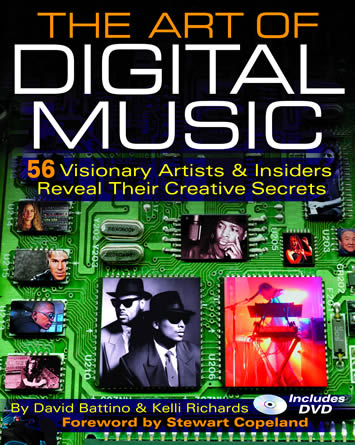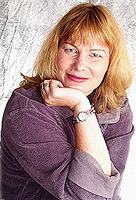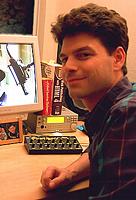 |
|
| Download
high-resolution cover image (3.7MB CMYK JPEG) Download press release (248KB PDF) |
|
1. REVIEWS
“Ever wish you could crawl inside the
mind of Thomas Dolby? How about hang in the studio with Herbie Hancock,
Jimmy Jam, or BT and watch them work? Then, my friends, The Art of
Digital Music is for you. If you think of yourself as a musician, you need to get this book.”
—Keyfax.com (Book of the Month)
“Amazing...a gem...truly entertaining and informative on
both philosophical and technical levels. With more than 250 pages jam-packed
with practical studio tips, thought-provoking interviews, and music business
advice, plus an intriguing DVD, we think The Art Of Digital Music is jolly good value for money. Definitely one for the studio bookshelf.”
—Music
Tech (Recommended Product; Verdict: 9/10)
“A fascinating and far-ranging collection sure to appeal to audiophiles
everywhere. Highly recommended.”
—Library
Journal (starred review)
“A must-have for musicians who use digital technology.”
—International
Musician
“Focuses on creativity rather than flavor-of-the-week tools, which
means it will stay relevant and useful for a long time to come. The
Art of Digital Music has taken an honored spot on
my shelf of beloved books.”
—Keyboard
“Looking for gifts for others, or yourself? One of my favorite
reads this year was The Art of Digital Music by David
Battino and Kelli Richards. It’s a really unique glimpse into the
creative life behind digital music, and it’s one of those books
you can just open to any page.”
—Create
Digital Music.com
“A fascinating compilation about the impact and uses of digital
technology in today’s music. If you really want to appreciate the
diversity of approaches to using technology to produce modern music, I highly recommend this book for curl-up-by-the-fire reading
for the holidays.”
—Performing
Songwriter
“Extremely easy to digest, incredibly well designed, very
unpretentious and readable. The advice given is not only helpful for the
beginner, but also the seasoned professional. And that’s this book’s
greatest achievement — its universal appeal.”
—Knowledge (UK)
“If you’re a student of music technology, this is a
must-have book. If you teach music composition at the high school
or college level, you’ll find a plethora of information for you
and your students. I particularly recommend that everyone read the essays
by Todd Rundgren and David Zicarelli on the DVD and use them to initiate
class discussions.”
—Music Educators Journal
“This book is the Bible of the music technology
industry.”
—DTM
Magazine (Japan)
“If you’re interested in music technology, The Art of
Digital Music is an absolute must-read.”
—Electronic
Musician
Reader Reviews
Amazon.com customers have given The Art of Digital Music a perfect 5-star rating. At launch, it was a top-ten bestseller and the #1 most relevant search result in the digital music books category:

—Gina Fant-Saez (Amazon customer)
“I think this book is superb. It touches on just about all the major angles and issues of the digital music world. The interviews are concise, philosophical, and highly educational. Highly recommended.”
—JC (Amazon customer) “I have started to reread this book and still recommend it to all of us creative geniuses. I have found it invaluable when in a creative slump, lost with too much technology, and not producing as much music as I should. And this is now a year later.”
—Jim (Karma Lab Forum)
“Your book was very much enjoyed here, too. It was like having a chat with a bunch of people that you’d love to have the opportunity to chat with about this stuff. Very interesting reading indeed. Thank you!”
—Daz (Karma Lab Forum)
2. BACKGROUND
“Usually books on music technology
are about as dry as database manuals.
But reading this one is like eavesdropping on great artists and
creative tech geniuses. Just about everybody
has something interesting to say.”
—Mark
Mothersbaugh
This book is designed to instruct and inspire two groups of readers: those who want to use technology to make better music, and those who want to learn how technology is changing the way music is created, experienced, and shared. Unlike a typical how-to book, The Art of Digital Music will captivate readers by showing them firsthand how top artists — pioneers such as Alan Parsons, Herbie Hancock, BT, Todd Rundgren, Steve Reich, and Phil Ramone — use digital technology in their work. (Jump to interviewee list.)
In addition to interviews with artistic pioneers, The Art of Digital Music features lively discussions with technological pioneers — the producers, engineers, software wizards, and Internet visionaries who are shaping the sound of the future. The authors enhance the book with numerous how-to sidebars and provocative pull quotes, providing instant gratification and multiple entry points. (The authors’ backgrounds in marketing and magazine design help shape the book’s look and feel, making it colorful and interactive instead of grimly linear.)
Musicians, producers, audio engineers, students, and more will be rewarded with useful knowledge and techniques that they can apply to their own work. Music enthusiasts will find the book compelling, too, because it provides insight into the ways digital tools are changing how music is made and distributed, as well as offering an up-close view of favorite artists in production and behind the scenes. All readers will become more aware of the pivotal role computers play in shaping today’s music (from pop to classical to cutting-edge interactive formats) and will come away with a better understanding of the music being produced today. And of course, the star-power appeal of the book will interest even the most casual reader.
The book includes an enhanced DVD (Mac/PC/video), featuring sound bites from all 56 interviewees, Web links, and more. The disc also contains music videos from the artists interviewed, increasing the book’s appeal to non-technical readers.
In short, The Art of Digital Music (and its tightly integrated disc and Web site) embraces and amplifies digital music and its heroes — their sounds, their grooves, and their rule-breaking techniques. It delivers musical instruction and inspiration in a voice that is hip, entertaining, and absolutely non-condescending.
3. OUTLINE
“Astonishing depth and variety
—
there’s some real inside information here.”
—Eliot
Van Buskirk, MP3.com
Foreword
Written by Stewart Copeland, founder of the multiplatinum group The Police and computer-powered composer of more than 60 movie soundtracks, this essay describes the surprising ways technology has shaped his artistic work. Through personal anecdotes, Copeland explores how technology is blurring the boundaries between artists, hobbyists, and fans. (Few people realize the extent to which digital technology is shaping the music they hear today — or how easy it now is to make music themselves.) Because the goal of this book is to equip and inspire the reader to do something creative, Copeland also gives readers “permission” to become more deeply involved in music.“The how-to guide for
harnessing your inner rock star.”
— Tommy Shaw, Styx
Introduction
This section explains the story behind the book, from the unique “cocktail party” approach that made the interviews so lively to the custom software the authors developed to help transcribe them. More on the software here.SECTION I — Individual Interviews (45% of page count)
This section introduces the interviewees, with one chapter per person. Each interview features personal anecdotes and insights complemented by photographs of the creators in action. Sidebars add intriguing background information on the technology and examine the influence the artists’ work has had on other artists. Web links are sprinkled liberally throughout. Some questions we ask:Production
- What are three sneaky ways to mangle a sound and make it yours?
- Anyone with a $49 copy of Acid or GarageBand can combine indigenous sounds from all over the world, or make super-groups of musicians who otherwise would never have met. What are some technical and aesthetic tips for combining sounds effectively?
- What are two grossly underexploited MIDI and digital audio tricks?
- There’s a thin line between repetition and boredom. How do you warp loops and phrases to keep them interesting?
- What makes a killer remix? What destroys one?
- How can musicians make their own music stand out sonically now that everyone has access to the same powerful tools?
- What parameters work best for wringing expression from electronic instruments?
“Despite having a thorough technical
background,
this book never forgets that
‘art’ is the key word in ‘state of the art.’”
—Craig
Anderton
Philosophy
- Have you had any happy accidents when a program or a piece of gear didn’t perform the way you expected? How did you capitalize on them?
- One thing that’s been lost in the era of computer-powered one-man bands is the synergy between human band members. What tips do you have for restoring that creative dialog?
- Why the heck do so many music programs look like spreadsheets? It seems like that unnecessarily boxes us in. What’s a better approach?
- How could the techniques of interactive music composition (transitions, variations, etc.) enhance linear music?
- Software designers go to extraordinary lengths to emulate familiar controls like knobs onscreen. What types of interfaces will we see once designers start thinking beyond those “analog” constraints, and how will that affect the music?
- How could computers themselves be made more musical? Conversely, how could people become more emotional and intuitive in their approach to using computers?
Business
- What could be done to extend the CD/DVD platform or offer more value?
- What needs to happen before online music really takes off?
- In the digital future, how will artists be compensated fairly?
- Digital “rights” management: worthwhile?
- There’s a rush to sell music as a service rather than a product, but doesn’t that contradict the basic human desire to hunt and gather? What services would be truly appealing?
- How can listeners find good music in the deluge of new recordings?
The Future
- Traditional instruments strive to sound vocal: We talk about screaming guitars and wailing saxophones. What future do you see for singing synthesis?
- What new instruments and playback technologies (interactive, surround, higher resolution, video-enhanced, etc.) would you like to have? How would you use them?
- Programs like Ableton Live and gear like Roland’s V-Synth are blurring the distinction between digital audio and MIDI. Where’s it all going?
- Many older recordings sound dull and wimpy today. How can we (or should we) ensure that what we’re producing now will hold up for future listeners?
- Twenty years from now, when we all have wireless broadband receivers implanted in our skulls, will we be paying for silence instead of music?
SECTION II — Roundtables (55% of page count)
Building on trends uncovered in the interviews, this section organizes related responses into virtual roundtables. Again, intriguing pull quotes and sidebars provide multiple entry points. The section concludes with a provocative look at the ways creative technology will be shaping music and society in the years to come. Some chapters:- Success Through Failure: Making the most of happy accidents
- Synth Charming: How to squeeze soul out of electronic instruments
- Online Music: Utopian and Hellish predictions
- Records: R.I.P.?: Ideas to enhance CDs and DVDs
- Hands On: Interface designs that facilitate creativity
- Producing in the Digital Domain: Benefits and perils of “cranking it up to 1”
- Support Our Loops: Finessing the fine line between repetition and boredom
- Phone It In: Making mobile music
- Playing Games: Insights from the interactive music world
- Too Many Notes: Overcoming option anxiety
- Quantize This: Exploiting the creative tension between machine and human feel
- Distortion is Art: How to use it to your advantage
- The Future of Digital Music
4. DVD DETAILS
“A significant achievement: simultaneously
practical,
entertaining, and thought-provoking.”
—Scott
Banerjee, Billboard
Format
Enhanced DVD containing standard TV video as well as Mac and Windows multimedia.Content
- More than 25 complete songs (including two songs from a private Thomas Dolby concert, unreleased demos, and out-of-print classics)
- Behind-the-scenes photos
- Sound bites from all 56 interviews
- Performance videos
- Interactive Flash movies
- QuickTime VR (virtual reality) studio tours
- Hundreds of Web links to artist sites and related information
- Royalty-free samples (original loops and ambiences from the interviewees themselves)
5. SAMPLE CHAPTER
Electronic Musician excerpted most of the “Quantize This” chapter in its 2006 Computer Music Product Guide. Read it here (452KB PDF). To see the actual layout of the book and more pages, use the “Look Inside” feature on Amazon.com.
6. INTERVIEWEES
“You interview like Woody Allen
used to do standup —
you’ve prepared your questions but make it seem like
a spontaneous conversation with a friend.”
—Roger
Linn
ARTISTS (see note)
|
PRODUCERS
|
VISIONARIES
|
| NOTE: Most interviewees cross multiple categories (artist/producer/visionary). For clarity, we’ve grouped them here by their best-known achievements. | ||
7. AUTHOR BACKGROUND/CONTACTS
“I couldn’t resist interviewing Kelli Richards and David Battino about
the future of music, technology, and, most intriguingly, silence.”
— Andrew Keen, AfterTV
 Kelli
Richards, a veteran in the digital music/media
arena over the past two decades, connects the dots between major content
brands, established artists, dynamic technology companies, and consumer
brands to create innovative and profitable alliances. She has rich experience
as an executive and strategist with both mainstream entertainment (EMI,
others) and technology companies (including Apple Computer, SGI, and Philips),
where she focused on developing traditional and digital music and entertainment
initiatives for each. Kelli also pioneered the first Internet-based artist
subscription service, PatroNet, with Todd Rundgren in the mid-’90s.
And she has been a producer of awards shows, digital music/media conferences,
and celebrity fundraisers. Kelli recently co-authored the book, Create
Business Breakthroughs You Want: Secrets and Strategies of the World’s
Greatest Mentors, with notable co-authors including Mark Victor Hansen,
Robert G. Allen, and Brian Tracy.
Kelli
Richards, a veteran in the digital music/media
arena over the past two decades, connects the dots between major content
brands, established artists, dynamic technology companies, and consumer
brands to create innovative and profitable alliances. She has rich experience
as an executive and strategist with both mainstream entertainment (EMI,
others) and technology companies (including Apple Computer, SGI, and Philips),
where she focused on developing traditional and digital music and entertainment
initiatives for each. Kelli also pioneered the first Internet-based artist
subscription service, PatroNet, with Todd Rundgren in the mid-’90s.
And she has been a producer of awards shows, digital music/media conferences,
and celebrity fundraisers. Kelli recently co-authored the book, Create
Business Breakthroughs You Want: Secrets and Strategies of the World’s
Greatest Mentors, with notable co-authors including Mark Victor Hansen,
Robert G. Allen, and Brian Tracy. E-mail: click here
Web: www.allaccessgroup.com
 David
Battino, a lifelong musician, majored in philosophy at Oberlin but spent
most of his time tormenting synthesizers in the college’s electronic
music studios. That led to his designing sounds for Lazer-Tron arcade games
and Ray Charles’s album My
World. He is the founding editor of Music & Computers magazine and the Desktop
Music Production Guide, and has covered music technology for Electronic
Musician, Keyboard, MacAddict, MacHome, Maximum PC, and Productopia.com. David was also Technology Editor for Revolution, the biggest launch
in music-magazine history, where he designed and produced the monthly CD-ROM.
He launched and edited the O’Reilly
Digital Audio site and served five years on the steering committee of the Interactive
Audio Special Interest Group.
David
Battino, a lifelong musician, majored in philosophy at Oberlin but spent
most of his time tormenting synthesizers in the college’s electronic
music studios. That led to his designing sounds for Lazer-Tron arcade games
and Ray Charles’s album My
World. He is the founding editor of Music & Computers magazine and the Desktop
Music Production Guide, and has covered music technology for Electronic
Musician, Keyboard, MacAddict, MacHome, Maximum PC, and Productopia.com. David was also Technology Editor for Revolution, the biggest launch
in music-magazine history, where he designed and produced the monthly CD-ROM.
He launched and edited the O’Reilly
Digital Audio site and served five years on the steering committee of the Interactive
Audio Special Interest Group. E-mail: click here
Web: www.batmosphere.com
“Let’s suppose
I wanted to invite almost every leading mind
in the field of digital music over to my house
for an evening dedicated to the exchange of new ideas.
“The list would include many of my friends, contemporaries, and
professional heroes. I would make it very informal —
cushy chairs, good food, great conversation.
“And I would be sure to have David Battino and Kelli Richards
send out the invitations, for obviously no one can resist them.
“Well, here is your chance to join the party.”
—Jack
Douglas, producer (Aerosmith, Cheap Trick, John Lennon)
